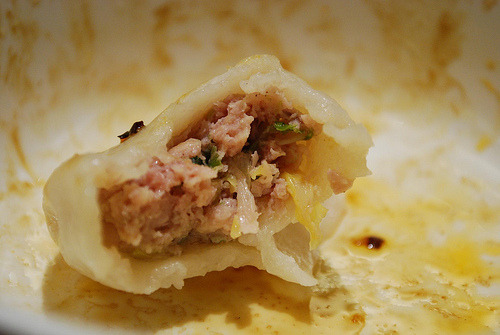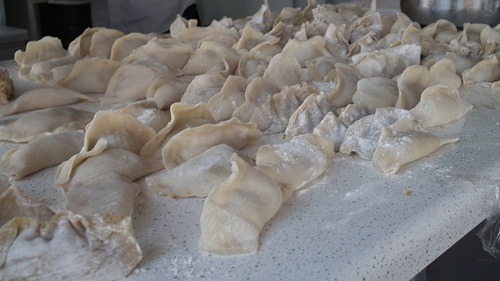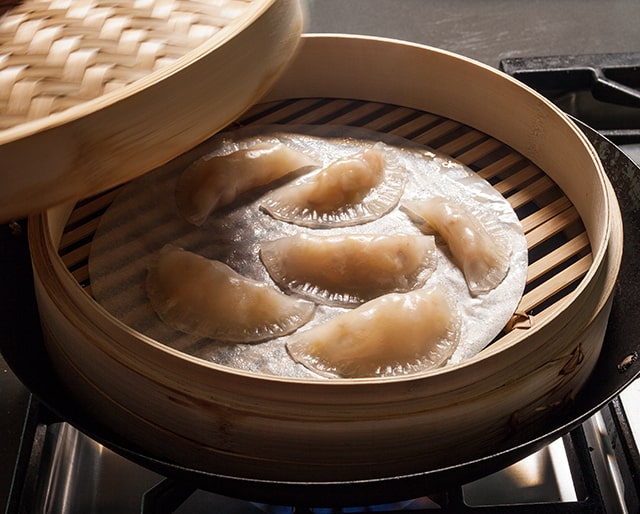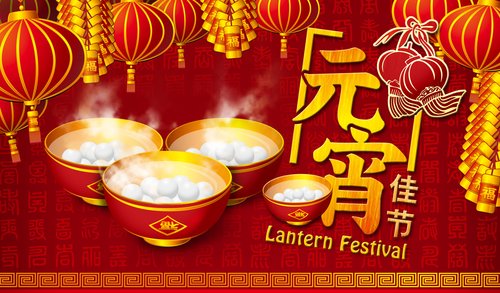The Year of the Tiger is just around the corner. Starting today, with 除夕, which is the Chinese New Year’s eve, 春节( chūnjié) celebrations mark the time to say goodbye to our Ox pal and welcome in the mighty Water Tiger. Here’s to hoping we’ll have a good year! What better way to start off the New Year celebrations than with a making/eating Dumpling party?
Great food and good company are bound to bring plenty of good vibes for the year to come…So, gather around your family – or friends if you’d rather, we won’t tell 😉 – , pick your favorite 饺子 (jiǎozi, dumpling) recipe and prepare for a serious dumpling party making session! To help you get ready for the 饺子 (jiǎozi) dumpling party of the year, here are a few recipes and tips on making the best Chinese dumplings around!
Getting the wrapper (皮 pí) ready
The real way to make wrappers
If you’re a hands-on kind of person, odds are you’ll want to get your hands in there and make the wrappings yourself. It’s a pretty straightforward recipe and as far as I’m concerned, nothing beats homemade cooking! It also requires very few ingredients; two in fact, that you most likely already have at home, namely water and all-purpose flour. Even the salt is optional. Sure, the kneading can be quite a workout, but it’s definitely worth the effort!
You’ll need: 2 cups of flour and 3/4 cups of water. Instructions on what to do next can be found here.
Rolling out the dough
Once your dough is ready, you need to tear it into little balls of doughs (1 ball = one dumpling) and them roll the balls out into small flat circles. Here’s how it’s done: You can also check out how to roll out the dough in a superfast mode here.
Cheating a bit
If you’re feeling lazy, unsure of your cooking skills, or just ran out of jiaozi dough and can’t face the idea of making some more (it might look like you made a zillion, but they’ll go in the blink of an eye!), wonton wrappers are an excellent substitute :). Read here and here on how to choose the best kind of Wonton wrappers at your local Asian store. They might also be called “gyoza” wrappers (Japanese name) or “potstickers.” Or nothing at all in English. As long as they look like a pile of wrappers, and have a picture of dumplings on them, they should work.
Tip: Wonton wrappers are typically stiffer than homemade dough (and sometimes square. The square ones require a bit more folding than round portions do. Since they’re stiffer, you might want to wet them a bit when handling them (to ensure they don’t crack). You can also brush (with a paintbrush – fingers work too!) water on the edges to make sure they stick together better.

If you don’t have a paintbrush, fingers work too! (Picture courtesy of the La Times )
Making the 馅 ( xiàn – filling)
Here are a few recipes to choose from
Now, when it comes to dumpling fillings, you can basically use whatever you want, following the one-meat/ choice of the chopped vegetable rule of thumb. Not very useful I know.
Traditional combinations are pork mixed with cabbage, leeks, Chinese chives (called 韭菜 – jiǔcài – way more fragrant than their Western counterpart!) or carrots. Then, of course, you can substitute chicken, mutton, or beef for the pork. Shrimp is also a very popular 馅 (filling) ingredient. Once you’ve decided on your meat and veg(s) of choice, you can pretty much play it by ear, focusing on fragrance and taste, adding a little ginger here, a little Sichuan pepper there, a dash of five-spice, salt, and pepper, a splash of sesame oil and cooking wine, chopped scallions; chives … and there! Your filling is ready!
You can also choose to follow a recipe that seems good to you. For example, these two sounded 好吃 (hǎochī, good): a pork one and a vegetable and almost no meat one. If you’re not a meat-eater at all, this vegetarian recipe seems really simple (not too many ingredients) and tasty. Then there’s this shrimp and chive recipe. I’m also considering this one, which calls for split peas and is a bit more unconventional but still has the potential to be excellent.

A flavorful and fragrant filling is really what makes the difference! credit: avlxyz
Overstuffing and other don’ts
What you want to watch out the most for is overstuffing. Overfilling the dumplings will unavoidably lead to leakage as you’ll most likely be plunging them in water to cook them the traditional way during the Chinese New Year. There are of course other ways to cook 饺子 (jiǎozi), but dumplings cooked in water are what you’re supposed to be eating on 除夕chúxī, New Year’s Eve…. So make sure your dumplings are well sealed to prevent leakage and water-filled dumplings!
Also, the filling should be moist but not too wet, so it can’t even pretend to try to seep through the wrapper. Remember: a holey dumpling = an empty dumpling wrapper once cooked.
And now, what you’ve been waiting for: how to fold the dumplings
Ready? Set? Fold!
The idea behind folding the dumplings is really simple: put a little filling in the middle of the dumpling and then fold it in half. Then move your thumbs along the sides, while pressing down to get the sides to stick together… You’re supposed to create pleats along the edge for extra-sealing. The hard part is getting it them to look nice, even and well-sealed. Mine always look lopsided and remind me of sad-looking dinosaurs… But once you get the hang of it, it’s quick to fold them.
Think dinosaurs when folding
If you do it properly, as in the video, the dumplings should look like proud dinosaurs instead. Much better!
Time to eat!
Cooking the dumplings
Ok, so now you should be facing a sea of uncooked dumplings, waiting to get cooked and eaten.

Making dumplings for the dumpling party sure takes a while, but it’s fun to do and well worth the effort!
How you choose to cook them is entirely up to you… But, as I mentioned before, boiling the dumplings in water (like making tortellini) is the traditional way of eating dumplings during the Chinese New Year. You’ll frequently come across dumplings served like that in China.
Boiled dumplings are called 水饺 shuǐjiǎo.
Other ways of cooking the jiaozis include pan-frying them or steaming the dumplings.
Steamed dumplings are called 蒸饺 zhēngjiǎo
Pan-fried jiaozis are actually called 锅贴 guōtiē
I really can’t say which cooking method I like most!
Making the dipping sauce and you’re ready for your Dumpling Party!
The last thing to prepare is the dumpling dipping sauce. The sauce is a traditionally a mix of Chinese black vinegar (醋 – cù) and soy sauce. You can add to this chilies, ginger, chives, and garlic.
Start with 125 ml of vinegar (cider vinegar or wine vinegar will also work as a substitute) and 30 ml soy sauce, and then add some ginger and chili. Tinker with the sauce until you find the taste you like best! I’ve had trouble getting used to Chinese black vinegar so my sauce is real simple: just soy sauce mixed with dried chili flakes.
Now, all that is left to do is eat and enjoy!
Making dumplings is a great group activity for 除夕 Chinese New Year’s eve. Sure, traditionally, it’s a family activity, but it’s always a great group activity to do during a dumpling party, whenever you feel like it!
虎年快乐! hǔniánkuàilè! Happy Year of the Tiger!
And one more thing…
If you want to continue learning Chinese with authentic and entertaining content, then you’ll love Ninchanese.
With Ninchanese, you get a complete method to learn Chinese which has you speaking, reading, writing, and more in Chinese. What’s more, whether you’re a beginner or an advanced learner, there’s content your level on Ninchanese and plenty more!
Start using Ninchanese on the web, with your computer or tablet, or, for Chinese learning in your pocket and on the go, download the Ninchanese app from the Google Play Store.
The Nincha Team
Stay in touch with us on Facebook, Twitter, Instagram, and Pinterest.






1 comment
Join the conversationPingback: 马年快乐! Happy Chinese New Year of the Horse! - Ninchanese
Comments are closed.